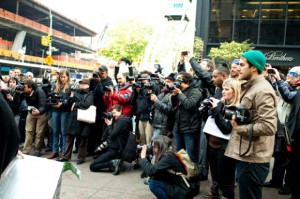 Somehow the AP headline “Occupy Wall Street becomes highly collectible” does not fill me with revolutionary fervor.
Somehow the AP headline “Occupy Wall Street becomes highly collectible” does not fill me with revolutionary fervor.
Where does this sense of preciousness come from? Since the early days of the revolution in Egypt, there has been a strong and tangible need to archive. This urge has birthed a number of exciting projects (in fact, I wrote about some of them here), but there is still something strange about paying so much attention to posterity. Maybe I’ve harped on the subject of nostalgia’s incompatibility with revolution enough at this point, even in this very blog. But the archiving and preservation of Occupy Wall Street seems to have kicked into overdrive recently, so I think the subject might be worth revisiting.
The AP story mentioned above includes this inspiring quote:
“Occupy is sexy,” said Ben Alexander, who is head of special collections and archives at Queens College in New York, which has been collecting Occupy materials. “It sounds hip. A lot of people want to be associated with it.”
In the face of such blatant opportunism, the Occupiers, understandably, are seeking to make sure they keep control of the movement’s legacy, and have formed an archives working group:
“We want to make sure we collect it from our perspective so that it can be represented as best as possible,” said Amy Roberts, a library and information studies graduate student at Queens College who helped create the archives working group.
With more than one OWS documentary in the works, articles popping up with titles like “Occupy Wall Street is History,” and a planned Occupy exhibition scheduled to take place at the City Museum of New York this month, I can’t help but wonder what has spurred all of this preserving and repackaging, and the seeming hyper-awareness of the historical importance of current events.
But I have a hypothesis.
Of course, there is no need to reemphasize the importance of social networks and cellphone cameras in movements like Occupy Wall Street and the revolution in Egypt — a plenty big deal has been made about their effectiveness as organizing tools and facilitation of international visibility. But we are all so accustomed to keeping a constant running commentary on our own lives, Instagramming the walk to work, tweeting lunch. That constant documentation kicks into overdrive when something is actually happening. And once the camera is running, it’s natural to start to think about what will happen to all that material. How will it be saved? How will it be remembered? How can I make sure that the Smithsonian doesn’t get my story wrong?
Your perspective on the present moment suddenly becomes wide-angle. There is some aspect of the world inside the smart phone that leads to a constant awareness of being watched, and wanting to make sure that what everyone sees is what you want them to see, now and in the future.
On the first day of Occupy Wall Street there seemed to be one professional quality camera per two or three protestors. People showed up with all of their gear, ready to document. Has there ever been a historical moment when the people living it were so deeply, painfully, purposefully aware of its historical momentousness?
This post may contain affiliate links.








